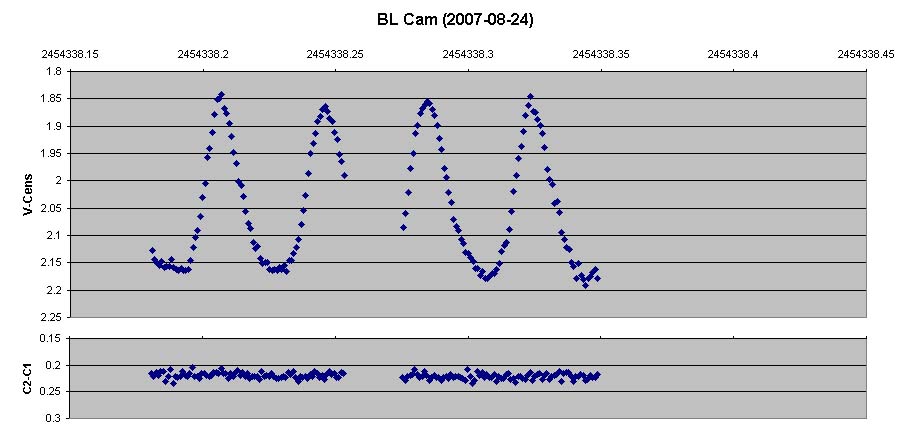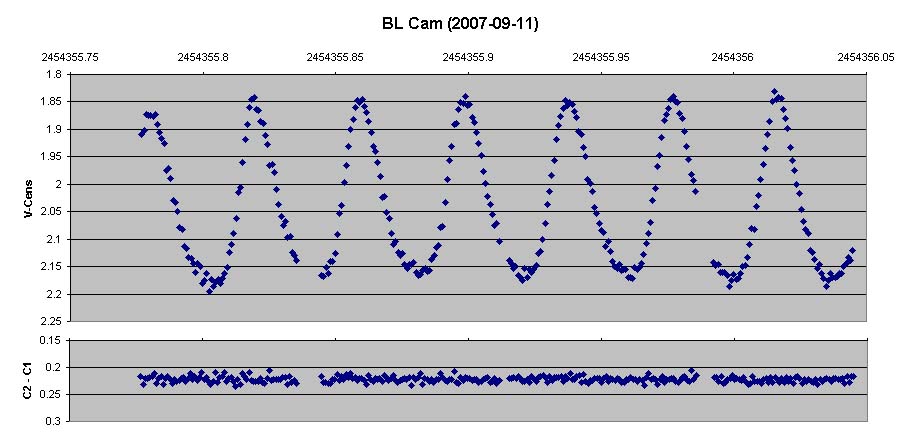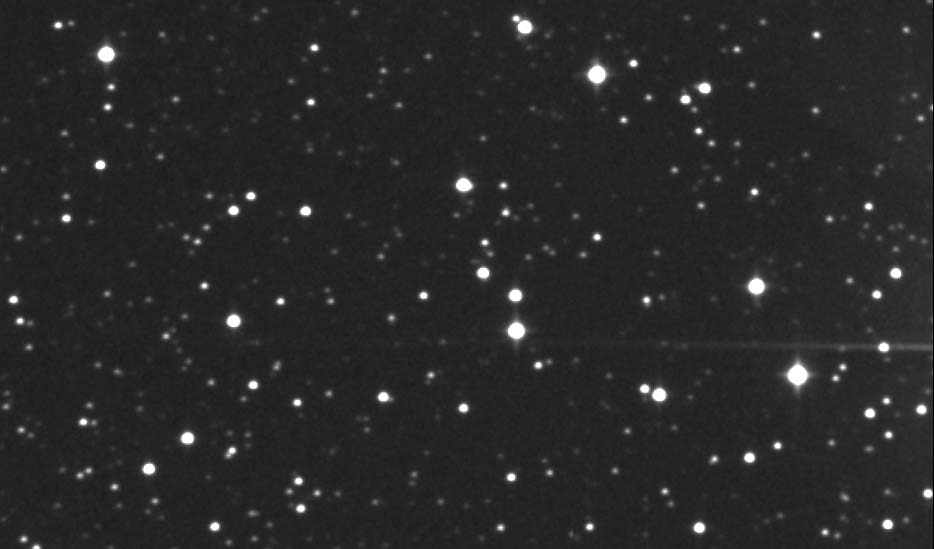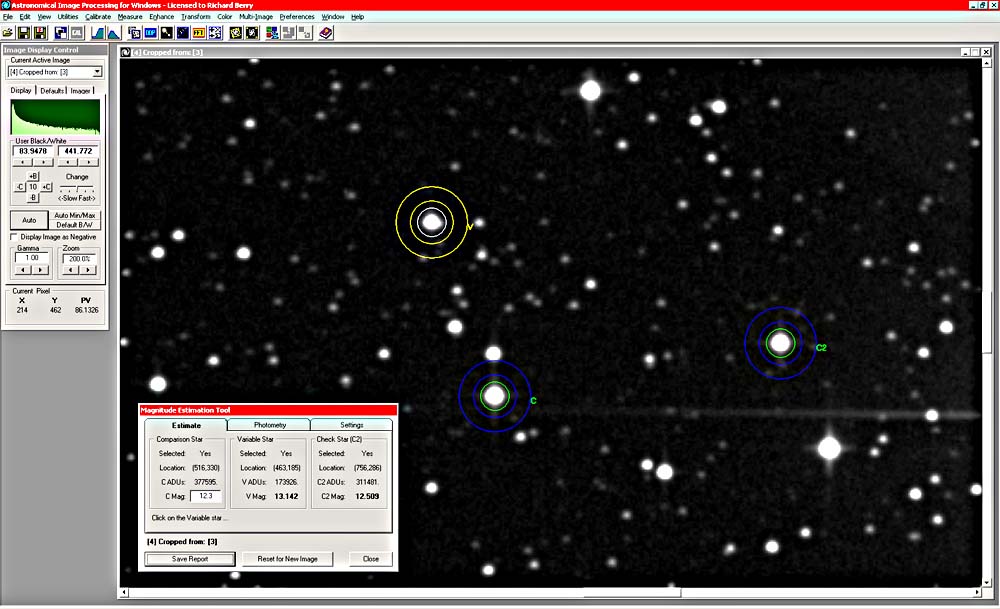Photometry of BL
Camelopardalis
|
Writing in Astronomy & Astrophysics (A&A 451, 999-1008 (2006)), astronomer Stefane Fauvaud states, "BL Cam is an extreme field multiperiodic short-period low-metallicity high-amplitude SX Phe-type variable where its probably complex pulsational content is subject of controversies." He continues, "BL Cam presents the second shortest period ( P = 0d.0391) among the known field SX Phe variables (the shortest one corresponds to PL43 = CS22966-043 ... with P = 0d.0374) and the shortest one among the high-amplitude objects of this type. BL Cam was originally reported by Giclas et al. (1970) as a possible white dwarf star. The variability of this object was discovered during a series of observations of white dwarf stars by Berg & Duthie (1977)." In short, BL Cam is a rather weird and interesting variable. For the amateur astronomer, BL Cam is attractive because because it goes through a complete cycle of variation with an amplitude of ~0.3 magnitudes in about 56 minutes! This makes it fun to observe, educational, and good for showing people that some stars really do nifty stuff. In addition, there are people who would like more data on this star. From a practical point of view, BL Cam is especially attractive because it is nearly circumpolar for northern observers so you can monitor it for many hours -- and to top it all off, BL Cam is easy to locate. As part of putting the QSI 532ws through its paces, I observed BL Cam on two nights (Aug 24/25 and Sept 11/12). I used a Vixen R200SS 200mm f/4 Newtonian reflector with a Paracorr coma corrector on my Byers 812 mount, taking continuous 60-second integrations interrupted only by resetting the Byers 812's sector gear and making calibration frames, over a span of 4.5 hours on Aug 24/25 and 6.2 hours on Sep 11/12. These observations are unfiltered, but I plan to make observations later this year using standard photometric filters.
|
|
Above is the light curve obtained August 24/25, with 163 data points. The amplitude of the variation of ~0.34 magnitude, and even with this somewhat incomplete light curve, you can see that the star does not exactly repeat each cycle. As a test of the QSI 532ws, the standard deviation of C2-C1 series is 0.0055 magnitudes, which matches the expected statistical error due to shot noise. This implies that the image data collected by this camera is limited solely by the number of photons detected. BL Cam's magnitude is differential, that is, it's the difference between the raw instrumental magnitude derived for BL Cam and the raw instrumental magnitude for the combination (an "ensemble") of the two comparison stars.
|
|
Above are plotted 297 measurements made the night of Sep 11/12. The magnitude plotted for BL Cam is a differential magnitude, that is, the difference between the raw instrumental magnitude derived for BL Cam and the raw instrumental magnitude for an ensemble composed of the two comparison stars. Here cycle-to-cycle variations are quite evident. Fauvaud's paper in A&A uses a larger and more comprehensive set of data to examine these light-curve variations. Note the tight clustering of the magnitude difference between the two comparison stars. This demonstrates that neither of the comp stars varied. The standard deviation of C2-C1 series is 0.0051 magnitudes, again consistent with images that are limited only by the number of photons available.
|
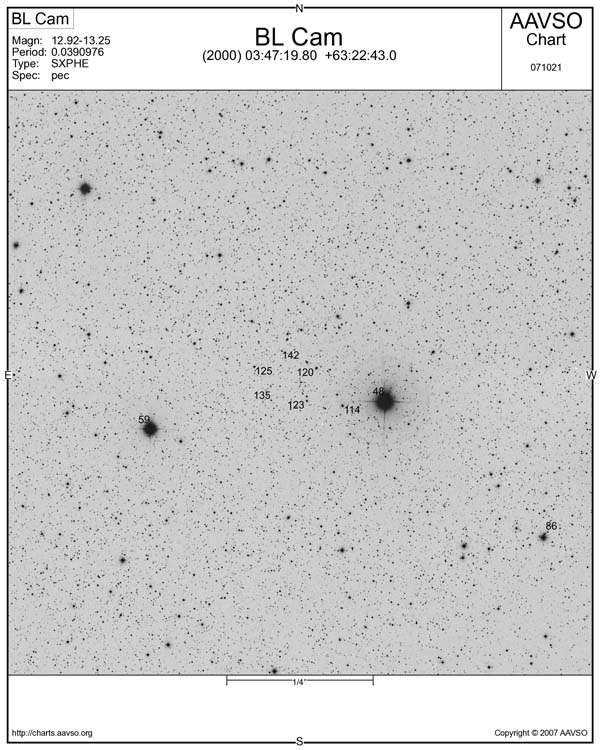 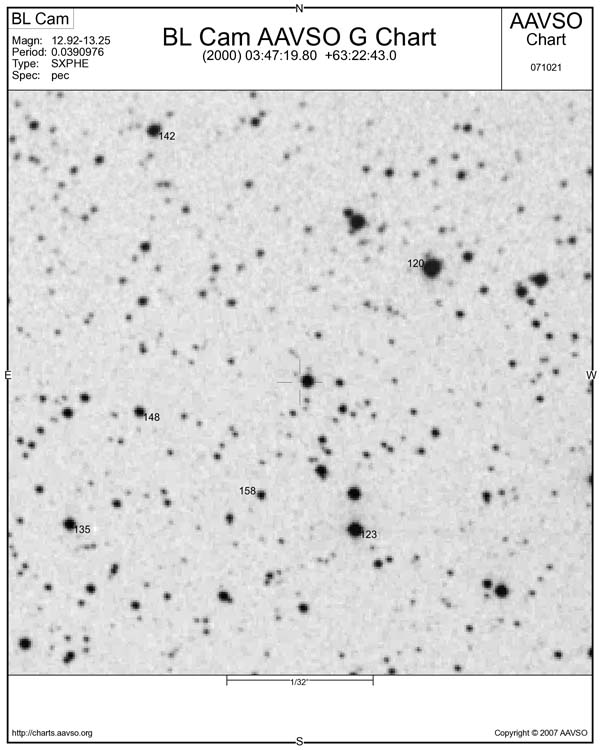 |
Here are two finder charts from the AAVSO. On the "D" chart (left), note the two bright stars. These are the middle two stars in a line of four fairly prominent stars about two-thirds of the way between Polaris and the middle of Perseus. These two stars are adjacent to an asterism called "Kemble's Cascade" found on Chart 16 of the Uranomtria 2000.0 Deep Sky Atlas. The AAVSO "G" chart is a closeup; BL Cam is located at the cross near the center. The new AAVSO charts use the digitized Palomar Observatory Sky Survey. To locate this field with binoculars, look at Polaris and then swing toward alpha Persei. About two-thirds of the way, you will see the line of four stars. Point your telescope between the two middle stars in the group. If you're making CCD images, when you have both of these stars in the field, you've also got BL Cam. The picture below shows a full frame taken with the QSI 532ws on the R200SS 8-inch f/4 Newtonian-plus-Paracorr.
|
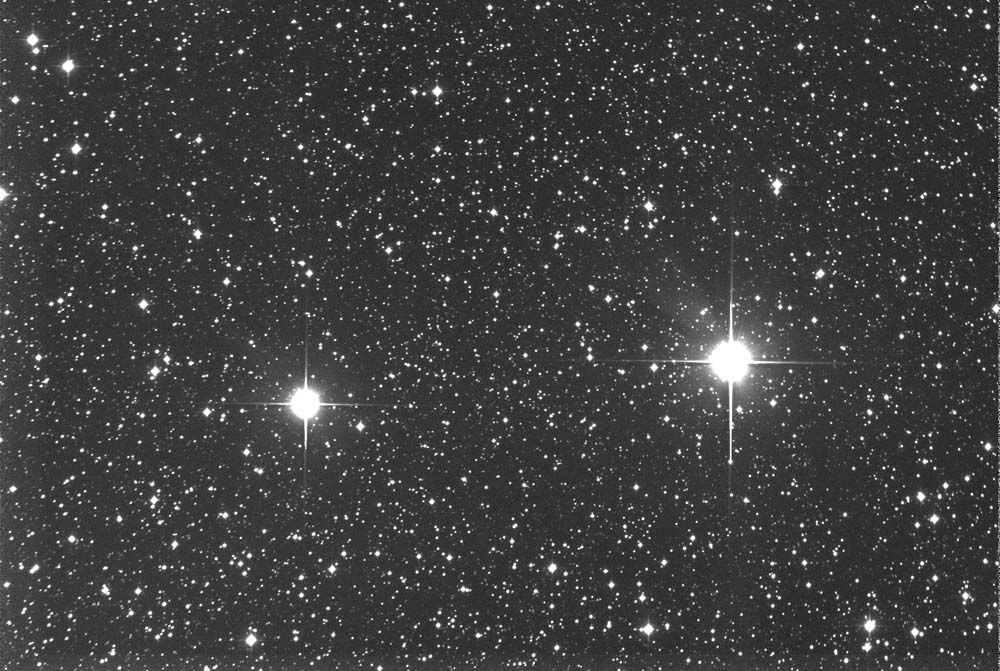 |
Above is the field of view at ~40% of full size, with north at top. You can see how rich this field is, and how many stars you get in a 60-second exposure. Because the CCD in this QSI 532ws was of the non-anti-blooming type, you can see a little blooming around the two bright stars (magnitude 5.0 and 4.8 in V). The blooming trails happen to be aligned with the spider diffraction spikes around the two stars. By the way, can you spot BL Cam? Below is a closeup cropped from this frame and shown at 200%. Compare the AAVSO "G" chart with the close-up view. Note how clean and smooth this image with an 8-inch telescope and CCD appears compared to the grainy POSS data taken with a 48-inch Schmidt camera. We've certainly come a long way!
|
|
Below is a screen shot showing the same field of view as the closeup and the two comparison stars that I used to produce the light curves at the top of this page. Although AIP4Win's new "Magnitude Estimation Tool" is shown here, I actually produced the data with AIP4Win's "Multi-Image Photometry Tool," which is designed for reducing image sequences to photometric data. In retrospect, one of the two comparison stars I used might not have been the best choice; the chart star 114 (AUID = 000-BBG-225) would have given me a slightly higher SNR. One of the beauties of doing CCD photometry is that you can go back and re-do a set of images.
|
|
In the screenshot above, the V, C, and C2 star images are surrounded by multiple rings. The innermost ring defines the aperture, a measuring window in which pixel values are summed to determine how much light came from the star and its little chunk of sky. The next two rings define the annulus, a donut-shaped area that we use to determine the brightness of the sky. AIP4Win determines how much of the light in the aperture comes from the sky, then subtracts this from the total light in the aperture to get the brightness of the star. This is converted into magnitudes. At the same time, a statistical model based on the number of photons received in the aperture and annulus determines the statistical uncertainty of the measurement. Thus, in just three clicks of the mouse, you get a magnitude estimate with an estimate of its uncertainty. |
Well, that's the story. Insofar as photometry with the QSI 532ws is concerned, what impressed me was that the camera performed to the theoretical limits of the photon count. You can't do better than that for detectivity. More rigorous testing is probably in order, especially at the short-wavelength end of the spectrum (blue and ultra-violet) where the KAF-3200ME's indium-tin-oxide intra-pixel gate structures might have some effect -- but it's also worth noting that the KAF-3200ME is also ~10 times more sensitive at 400nm than all-polysilicon based CCDs, so this CCD in effect enhances the blue and opens the formerly closed UV band to practical amateur use. It is interesting to note that the Fauvaud paper has a significant amateur component: "Most of the data have been obtained with the 0.62 m telescope at the Château-Renard Observatory (2930 m altitude, Saint-Véran, French Alps), a facility operated by the Paris-Meudon Observatory and AstroQueyras, an amateur association, and also with the 0.85 m telescope at the Xinglong Station, Beijing Astronomical Observatory (China). Some additional observations have been collected at Mo i Rana Observatory (Norway) with a 0.20 m telescope, at McDonald Observatory (USA) using the 2.10 m Otto Struve telescope, and at Sulphur Flats and Rockville observatories (USA) with 0.40 and 0.45 m telescopes, respectively. In total, more than 100 h of useful data were obtained on 28 nights." Fauvaud concludes: "BL Cam obviously deserves continued photometric monitoring in the coming years. Remaining observational issues are to confirm our detected frequency content, pulsation behaviour and checking our O-C binary hypothesis. To shed some light on these issues, the organization of a coordinated multisite photometric campaign with observations from several observatories at different longitudes would be of a great importance. We are already working in this direction for the near future." --Richard Berry |
Examine some non-science CCD images I made with the QSI 532ws. Return to Richard Berry's Home Page |
